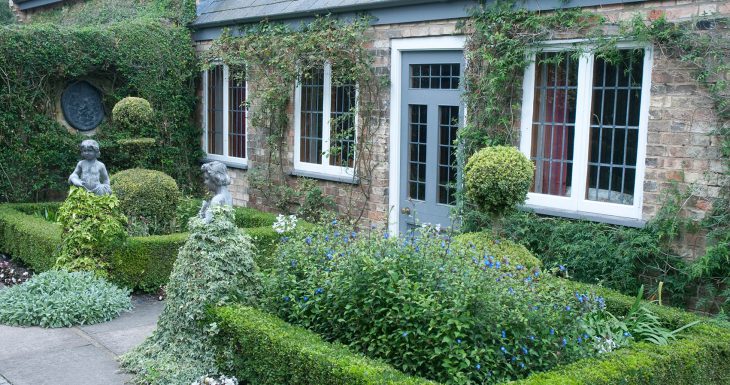Netherhall Manor
Walled garden around a recently restored manor house with a collection of rare plants nurtured by the owner and saved from extinction.
Soham, Ely, Cambridgeshire, CB7 5AB

A manor of Soham known as Netherhall Wygorne was held by Sir John Tiptoft, later Lord Tiptoft, descending to his son John, later Earl of Worcester. His son died without issue. His estates including the Soham Manor were partly inherited by his sister Joan Ingoldisthorpe. After her death they were divided amongst her daughter Isabel’s five daughters.
The Soham Manor was assigned to Margaret who married firstly Sir John Mortimer. Her next husband Charles Brandon divorced her in 1507. She took refuge with Edward Besteney, Soham’s wealthiest resident, worth 400 marks in 1522. He took the lease of Netherhall Manor and in 1518 induced her to sell him its reversion. Timothy Clark is his twelfth great-grandson.
On his death his estates were divided between his two daughters’ husbands. Edward Barnes marrying his daughter Margaret, dominating the parish for 70 years, before his grandson sold the Lordship. It eventually passed to Thomas Chichelely in 1690, then descending with the Duchy Manor.
His second daughter Joan married Simeon Stuart from Stuntney, Ely, becoming one of the great-grandmothers of Oliver Cromwell. This gave Oliver a legitimate claim to the throne of England through descendancy from the Lord High Steward of Scotland, the first of Scotland’s Stuarts.
Oliver Cromwell’s son Henry Lord Lieutenant of Ireland lived at Spinney Abbey, Wicken. He married Elisabeth Russell of Chippenham. Their daughter married Sir William Russell of Chippenham in the next generation. They lived at the height of society accumulating substantial debts. He fled to London to escape his creditors leaving behind a numerous family. Two daughters were left in poverty in Fordham. Sir Charles Wager who bought the estate – a friend of their grandparents – built Cromwell House in Fordham to protect them. Martin Wilkin gent, the steward of the Soham and Fordham Manors did not protect them, a series of illegitimacies resulted. They went down in the world, not corrected until the widower James Barton of Barton Mills married their descendant Adelaide Woolard. She was so delighted with this, she had a watch made especially for him. The name James Barton was printed instead of numerals. Some ten years later she lost her remaining wealth in the cattle plague. To relieve her poverty she doctored the people of Wicken with a Culpeper’s Herbal. Timothy Clark keeps the book today. Her son and granddaughter maintained the garden and plants, which he regularly visited as a child. Timothy Clark commenced gardening at an early age. In his teenage years, he corresponded with Gladys Peto and Roy Genders on Tudor primroses. Roy Genders taught him Latin before he wrote over ninety books on gardening.
Timothy Clark married in 1959 and with taxation at over 80% it was essential to produce food from the garden. The garden was designed to save historic plants, at a time when every fifth day a house of some architectural importance was being demolished.
